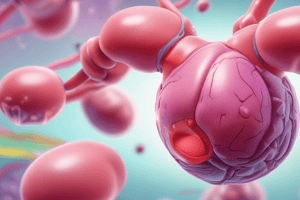Podcast
Questions and Answers
What is drug clearance defined as?
What is drug clearance defined as?
- The volume of plasma cleared of a drug over a specified time period (correct)
- The rate at which a drug is removed from the body
- The concentration of a drug in the plasma
- The total ability of the body to clear a drug from the plasma
How is drug clearance calculated?
How is drug clearance calculated?
- Rate of drug removal from plasma divided by drug concentration in plasma (correct)
- Rate of drug removal from body divided by drug concentration in plasma
- Rate of drug removal from plasma multiplied by drug concentration in plasma
- Rate of drug removal from body multiplied by drug concentration in plasma
What does drug clearance not tell us?
What does drug clearance not tell us?
- The concentration of drug in the plasma
- The amount of drug cleared (correct)
- The volume of plasma cleared of a drug
- The rate of drug removal from the body
In first-order kinetics, what happens to the drug clearance over time?
In first-order kinetics, what happens to the drug clearance over time?
Which type of kinetics exhibits constant drug clearance regardless of changes in plasma concentration?
Which type of kinetics exhibits constant drug clearance regardless of changes in plasma concentration?
What is the primary mechanism for drug elimination in the majority of cases?
What is the primary mechanism for drug elimination in the majority of cases?
In which type of kinetics can drug clearance vary due to changes in plasma concentration?
In which type of kinetics can drug clearance vary due to changes in plasma concentration?
What does drug clearance play a crucial role in determining?
What does drug clearance play a crucial role in determining?
Which factor is inversely related to the total body clearance of a drug?
Which factor is inversely related to the total body clearance of a drug?
In which type of patients can drug clearance be severely impacted?
In which type of patients can drug clearance be severely impacted?
How can a decrease in serum proteins affect drug clearance?
How can a decrease in serum proteins affect drug clearance?
What does clearance (Cl) represent in pharmacokinetics?
What does clearance (Cl) represent in pharmacokinetics?
What does total body clearance equal to?
What does total body clearance equal to?
For which type of kinetics is clearance almost synonymous with renal clearance for many drugs?
For which type of kinetics is clearance almost synonymous with renal clearance for many drugs?
In which type of kinetics is clearance variable?
In which type of kinetics is clearance variable?
What can clearance refer to when referring to redistribution between body compartments?
What can clearance refer to when referring to redistribution between body compartments?
What is the equation for total clearance?
What is the equation for total clearance?
How does an increase in total clearance affect the elimination rate half-life, assuming constant distribution volume?
How does an increase in total clearance affect the elimination rate half-life, assuming constant distribution volume?
For substances with substantial plasma protein binding, what does clearance depend on?
For substances with substantial plasma protein binding, what does clearance depend on?
How does extensive plasma protein binding affect clearance compared to substances not binding to protein?
How does extensive plasma protein binding affect clearance compared to substances not binding to protein?
What does the mass removal rate depend on?
What does the mass removal rate depend on?
In sites other than the kidneys, how may extensive plasma protein binding affect clearance?
In sites other than the kidneys, how may extensive plasma protein binding affect clearance?
What type of equations are derived from the mass balance equation?
What type of equations are derived from the mass balance equation?
What does the general solution to the differential equation provide?
What does the general solution to the differential equation provide?
How does the steady-state solution relate mass removal and clearance?
How does the steady-state solution relate mass removal and clearance?
How can renal clearance be measured?
How can renal clearance be measured?
What is drug clearance the result of?
What is drug clearance the result of?
When is renal clearance clinically relevant?
When is renal clearance clinically relevant?
What does continuous renal replacement therapy (CRRT) rely on for drug removal?
What does continuous renal replacement therapy (CRRT) rely on for drug removal?
What determines the rate of drug removal in continuous renal replacement therapy (CRRT)?
What determines the rate of drug removal in continuous renal replacement therapy (CRRT)?
What do sieving coefficients allow calculation of in the context of CRRT?
What do sieving coefficients allow calculation of in the context of CRRT?
What is total clearance in patients undergoing extracorporeal treatment the sum of?
What is total clearance in patients undergoing extracorporeal treatment the sum of?
What plays a crucial role in drug clearance and metabolite formation?
What plays a crucial role in drug clearance and metabolite formation?
What dictates drug metabolism and elimination?
What dictates drug metabolism and elimination?
What do pediatric drug dosing considerations include differences in compared to adults?
What do pediatric drug dosing considerations include differences in compared to adults?
What should creatinine elevation prompt in pediatric patients?
What should creatinine elevation prompt in pediatric patients?
What does drug clearance on CRRT depend on?
What does drug clearance on CRRT depend on?
What processes are involved in drug clearance by the kidney?
What processes are involved in drug clearance by the kidney?
What is the kidney involved in regarding drug metabolism?
What is the kidney involved in regarding drug metabolism?
What is drug elimination primarily responsible for?
What is drug elimination primarily responsible for?
Which organ is mainly responsible for drug biotransformation?
Which organ is mainly responsible for drug biotransformation?
What plays crucial roles in drug transport mechanisms in the kidney proximal tubule and hepatic cells?
What plays crucial roles in drug transport mechanisms in the kidney proximal tubule and hepatic cells?
How is hepatic drug clearance influenced?
How is hepatic drug clearance influenced?
What processes are involved in renal elimination of drugs?
What processes are involved in renal elimination of drugs?
How can protein-energy malnutrition (PEM) affect drug clearance?
How can protein-energy malnutrition (PEM) affect drug clearance?
What does enteral or parenteral nutrition (PN) improve in undernourished patients?
What does enteral or parenteral nutrition (PN) improve in undernourished patients?
In young children, what influences hepatic metabolic clearance?
In young children, what influences hepatic metabolic clearance?
When are maturational changes in the determinants of hepatic metabolic clearance most pronounced?
When are maturational changes in the determinants of hepatic metabolic clearance most pronounced?
Why is understanding the ontogeny of drug-metabolizing enzymes crucial for the appropriate use of certain drugs in young children?
Why is understanding the ontogeny of drug-metabolizing enzymes crucial for the appropriate use of certain drugs in young children?
Flashcards are hidden until you start studying
Study Notes
Drug Clearance and Renal Replacement Therapy
- Continuous renal replacement therapy (CRRT) relies on ultrafiltration of plasma water to remove ultrafilterable drugs, using membranes with larger pore sizes and involving convective transport of solute.
- CRRT can remove larger molecules (up to 5000 daltons) but is limited by protein binding and device filtration rate, which determine the rate of removal.
- Sieving coefficients allow calculation of drug loss if the ultrafiltration flow rate is known, with a coefficient closer to 1.0 indicating more passage across the filter.
- Drug clearance from the body involves renal excretion, extrarenal pathways, and metabolism, impacting drug removal in critically ill patients.
- Total clearance in patients undergoing extracorporeal treatment is the sum of extracorporeal, no renal, and residual renal clearance, complicating dose modification calculations.
- Cytochrome P450 enzyme activities play a crucial role in drug clearance and metabolite formation, with species differences being important to consider in drug metabolism research.
- Liver and kidney function dictate drug metabolism and elimination, with impaired liver function in obesity and higher renal clearance in obese patients without kidney failure.
- Pediatric drug dosing considerations include differences in renal function, plasma protein levels, and water-soluble drug distribution compared to adults.
- Nephrotoxic medications should be avoided in pediatric patients when possible, and creatinine elevation should prompt a review of all medications and considerations for accurate GFR assessment.
- Drug clearance on CRRT depends on ultrafiltration rate and molecular characteristics of the medication, such as molecular weight, charge, volume of distribution, water solubility, and protein binding.
- Drug clearance by the kidney involves glomerular filtration, active secretion, and metabolism, with uptake and secretion processes mediated by specific transporters and proteins in the proximal tubule cells.
- The kidney has significant CYP activity and is involved in drug metabolism via Phase II reactions, with secretion of conjugated drugs and amphiphatic molecules occurring across specific membrane proteins.
Drug Elimination and Clearance
- Drug elimination refers to the irreversible removal of drugs from the body through excretion and biotransformation processes.
- Excretion involves the removal of intact drugs through various routes, such as renal excretion, bile, sweat, saliva, milk, or expired air for volatile drugs.
- Biotransformation, mainly occurring in the liver, chemically converts drugs into metabolites through enzymatic processes, with some drugs also undergoing nonenzymatic changes.
- Drug excretion and metabolism involve complex rate processes within the body's organs, with specific functions and varying elimination processes in different tissues.
- Four classes of transporters - multidrug resistant protein (MRP), organic anion transporter (OAT), organic cation transporter (OCT), and P-glycoprotein (Pgp) - play crucial roles in drug transport mechanisms in the kidney proximal tubule and hepatic cells.
- Hepatic drug clearance is influenced by hepatic blood flow, the amount of free drug in the blood, and hepatic clearance of the unbound drug, with alterations in presystemic metabolism and hypoalbuminemia affecting drug clearance.
- Renal elimination of drugs involves glomerular filtration, active tubular secretion, and passive tubular excretion, with nutritional status impacting medications primarily renally filtered and excreted.
- Protein-energy malnutrition (PEM) can result in decreased cardiac function, affecting renal and hepatic perfusion, and reducing renal elimination and hepatic drug clearance.
- Enteral or parenteral nutrition (PN), particularly the protein component, improves the systemic clearance of susceptible drugs in undernourished patients transitioning from unfed to fed states.
- In young children, hepatic metabolic clearance is influenced by maturational changes in drug-metabolizing enzymes, hepatic blood flow, plasma protein binding, and active transport processes.
- Maturational changes in the determinants of hepatic metabolic clearance are most pronounced in the first months and years of life, with significant interindividual variability in the youngest age ranges.
- Understanding the ontogeny of drug-metabolizing enzymes is crucial for the appropriate use of certain drugs in young children, with limited knowledge on the maturational processes influencing hepatic drug clearance.
Studying That Suits You
Use AI to generate personalized quizzes and flashcards to suit your learning preferences.




